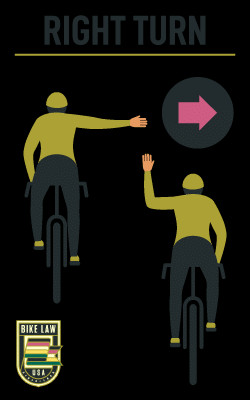Before you get behind the wheel of a car, you learn the rules of the road, including the vital practice of signaling your intentions. This same principle applies to cycling. Just as drivers use turn signals and brake lights, cyclists rely on hand signals to communicate with motorists, pedestrians, and fellow riders. Understanding and using Hand Signals For Bike Riding is not just a courtesy—it’s a crucial element of road safety for every cyclist.
Across the United States, while laws mandating bike hand signals might not always be strictly enforced, their importance is undeniable. These signals act as a universal language on the road, clearly indicating your intended movements. A look at bicycle accident case results consistently highlights how miscommunication can lead to serious incidents. Mastering just three basic bike hand signals can significantly enhance your safety and help prevent accidents.
If you’re not already incorporating hand signals into your rides, now is the perfect time to start. Below, we’ll break down the essential hand signals every cyclist needs to know to ensure safer and more predictable riding.
Why Use Bike Hand Signals?
In 2015 alone, the Centers for Disease Control and Prevention (CDC) reported over 1,000 cyclist fatalities and approximately 467,000 bicycle-related injuries in the US. While factors like road conditions and infrastructure play a role in these incidents, a significant number of crashes stem from misunderstandings between cyclists and drivers.
Bike hand signals are a proactive way to minimize the risk of collisions with cars. While no signal can eliminate the danger of reckless driving, clearly signaling your intentions makes it far less likely that a motorist will misinterpret your actions. By communicating your turns, stops, or lane changes, you create a safer environment for yourself and other road users.
Beyond interactions with motorists, hand signals are equally important for interacting with other cyclists. Whether you’re riding in a group, navigating shared bike paths, or simply in an area with other cyclists, hand signals are essential for group riding safety. Signaling your intention to stop, slow down, or turn provides crucial reaction time for those around you, helping to prevent pile-ups and maintain a smooth flow of traffic.
Essential Bike Hand Signals You Need to Know
Here are the three fundamental bike hand signals every cyclist should use. For each signal, it’s vital to quickly check behind you and make eye contact with other road users. This not only confirms they’ve seen your signal but also gives you a better understanding of the traffic situation around you.
Whenever possible, signal your intentions about 100 feet before you plan to turn or stop. This advance warning gives drivers and other cyclists ample time to react and allows you to safely return both hands to your handlebars as you execute your maneuver. Hold each signal for approximately 3 seconds before initiating your turn or stop.
Left Turn
To signal a left turn, simply extend your left arm straight out to your side, parallel to the ground. Make this signal roughly 100 feet before your turn, giving those behind you clear notice and allowing you to regain full control of your bike as you turn.
Right Turn
 Cyclist extending right arm straight out to signal a right turn, demonstrating a common hand signal for bike riding safety.
Cyclist extending right arm straight out to signal a right turn, demonstrating a common hand signal for bike riding safety.
There are a couple of accepted methods for signaling a right turn. The most common and widely understood method is to extend your right arm straight out to your side, mirroring the left turn signal but on the opposite side.
However, some regions or guides might suggest an alternative right turn signal. This involves extending your left arm out to the side and then bending your forearm upwards at a 90-degree angle, with your hand pointing upwards. Regardless of which right turn signal you choose to use, consistency and clarity are key. Ensure you signal about 100 feet before turning and hold the signal for around 3 seconds.
Stop or Slowing Down
The stop signal is arguably the most frequently used hand signal by cyclists. Unlike cars, most bicycles lack brake lights, making this signal essential for indicating deceleration or a complete stop. To signal that you are stopping or slowing, extend your left arm out to the side and then bend your forearm downwards at a 90-degree angle, with your hand open and pointing towards the ground. This clear signal effectively communicates your intention to reduce speed or come to a halt.
Prioritize Safety with Bike Hand Signals
Being involved in a bike crash can have devastating consequences for a cyclist. Beyond physical injuries, accidents can lead to emotional distress and long-term challenges. Using hand signals is a simple yet powerful way to enhance your safety and contribute to a more predictable and harmonious road environment for everyone. Make it a habit to use these essential hand signals on every ride.
If you have been injured in a bicycle accident, remember that resources are available to help. The Bike Law Network connects cyclists with experienced legal professionals who understand the unique challenges cyclists face. For expert guidance after an accident, reach out to the Bike Law Network today at 1-866-370-8796 to connect with a Bike Law Lawyer and learn about your options.
 Peter Wilborn, founder of Bike Law and experienced bicycle crash lawyer, advocate for cyclist safety and road awareness.
Peter Wilborn, founder of Bike Law and experienced bicycle crash lawyer, advocate for cyclist safety and road awareness.
Peter Wilborn
Founder of Bike Law and a dedicated bicycle crash lawyer, Peter Wilborn’s passion for cycling extends beyond recreation. His personal experiences and commitment to cyclist safety drive his legal practice.

